Original URL: https://www.theregister.com/2008/04/03/idf_inside_silverthorne/
'Diamondville' to shine as Intel's next Atom
Inside the 'Silverthorne' architecture
Posted in Channel, 3rd April 2008 08:55 GMT
IDF Having launched the first batch of 45nm Atom-brand processors yesterday, Intel today began touting the next set, these ones aimed at sub-laptops and small form-factor desktops rather than Mobile Internet Devices (MIDs).
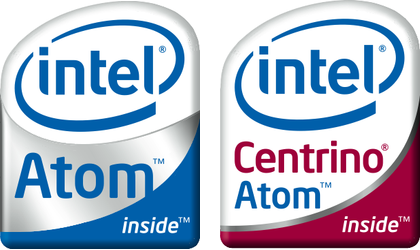
Codename watchers will be wondering where 'Diamondville' fits into Intel's Atom family, and now we know for sure. It's the part that will become the Atom N series, leaving the Atom Z series - aka 'Silverthorne' - for MIDs.
Diamondville and Silverthorne are based on the same microarchitecture, developed from the ground up under the Silverthorne codename since that was the first chip of the family to be developed. Both versions are fully compatible with the 'Merom' Core 2 Duo, so they're limited to SSE 3 rather than SSE 4, part of the 'Penryn' Core 2s.
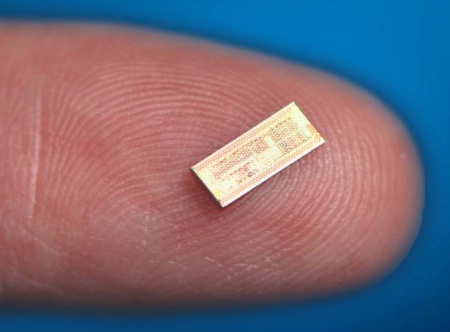
Small, isn't it?
But where Silverthorne lacks support for 64-bit addressing and Virtualisation Technology - they're not really needed on a handheld - they may well be present in Diamondville CPUs, almost certainly in the case of the desktop-oriented models.
Expect a number of mobile Diamondvilles, but the one Intel touted today is the N270. The chip giant confirmed it will be clocked at 1.6GHz and that it'll be paired with Intel's 945GSE northbridge and ICH7M southbridge rather than the more expensive, MID-oriented SCH series that combine with the Atom Zs to form Centrino Atom, a brand that's unlikely to be applied to Atom-based sub-notebooks.
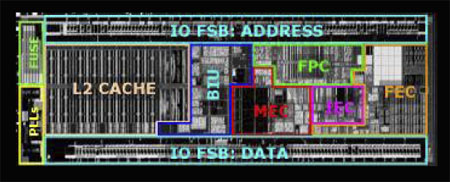
Inside Silverthorne
Desktop-centric Diamondvilles will be accompanied by the 945GC northbridge and ICH7 southbridge. Power consumption is less important here than it is with laptops, so expect Intel to drive these as-yet-publicly-unnamed Atoms on cost above all else.
The first desktop Diamondville is expected to be the 1.6GHz 230, though Intel itself has yet to confirm these numbers. Given it has the same clock speed as the N270, we might suggest it'll actually ship with a higher model number.
Intel executives admitted that Diamondville's clock speeds aren't directly comparable to those of the company's other mobile and desktop processors because all Atom chips have to process instructions in the sequence the commands appear in a program. This 'in order execution' contrasts with the 'out-of-order execution' technique employed by Merom, Penryn and other Intel CPUs to process whatever instructions they can, wherever they appear within a program. Silverthorne is Intel's first in-order CPU since the original Pentium. Its instruction processing pipeline is 16 steps long.
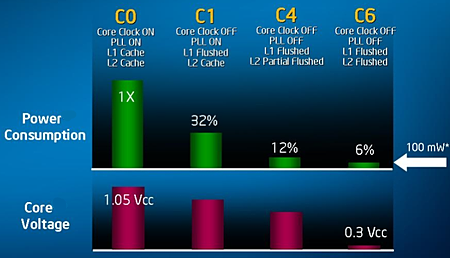
Power down: Silverthorne's sleep states
Out-of-order can boost performance because it means some instruction can be fed into CPU components that might otherwise be standing idle while another instruction is being dealt with. The upshot is that the chip can process more instructions in a give time, so it's faster. The cost is the complex circuitry needed to make this possible, circuitry missing from the Silverthorne and Diamondville architecture to keep the die size down.
To balance that, they use HyperThreading to try and keep otherwise un-utilised logic units occupied. How the absence of out-of-order and the presence of HT will balance out remains to be seen, so all we can say for now is that a 1.6GHz Atom N270 isn't necessarily going to be much faster than a 900MHz Celeron M - the Eee PC's processor - only that it probably will be. We'll have to wait for independently run benchmarks to find out for sure.
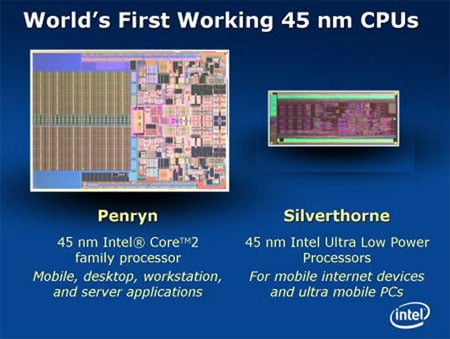
Silverthorne vs Penryn
For its part, Intel claimed this week that adding HyperThreading delivers a performance boost of around 37 per cent for an 18 per cent increase in power consumption when compared to a Silverthorne without HT running at the same clock speed.
The suggested chipsets mean Diamondville systems aren't going to be graphics powerhouses. With the emphasis on low costs, it seems unlikely that vendors will add in discrete GPUs to take over from the chipsets' GMA950 integrated graphics. If it happens, it'll be in desktops, but don't hold your breath.
Expect Diamondville to debut in June.